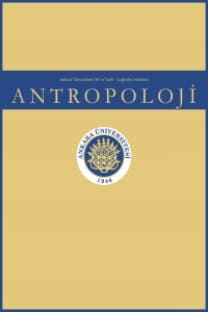Adli Antropolojide Perimortem ve Postmortem Kırıkların Ayırımı ve Travma Analizlerindeki Önemi
Adli antropologlar, maktüllerin kemikleri üzerinde inceleme yaparak bireyin, ölüm anındaki yaşı, boyu, cinsiyeti ve ölmeden önce geçirdiği travmaları veya hastalıkları gibi antemortem bilgilerini ortaya çıkarırlar; ölüm anında (perimortem) veya sonrasında (postmortem) meydana gelen travmaları tespit ederek, muhtemel ölüm sebebi hakkında tıbbi ve hukuki yetkililere yardımcı olurlar. Adli antropologlar, ölüme sebebiyet verebilecek travmaları belirlerken belli başlı özelliklere dikkat ederler. Ancak, perimortem ve postmortem kırıkların kendine özgü özellikleri olmasına rağmen bazı durumlarda birbirilerinden ayırmak oldukça güçtür. Böyle durumlarda kırık yüzeylerinin morfolojileri incelenir. Kırığın açısı, şekli ve kortikal kemikle arasındaki renk ve yapı farkı, analiz yaparken göz önünde bulundurulmalıdır. Bu makalede perimortem ve postmortem kırıkların kemikler üzerinde nasıl tespit edilebileceği, çeşitli travma türlerinde gösterdikleri özellikler, birbirileri arasındaki farklar ve birbirinden ayrılması güç durumlarda hangi yöntemlere başvurulabileceği tartışılmıştır
Differentiating Perimortem and Postmortem Fractures in Forensic Anthropology and Their Importance in Trauma Analyses
Forensic anthropologists assist medicolegal officials with determination and interpretation of perimortem and postmortem traumas on the bones of the deceased. Although the fractures caused by these traumas has typical characteristics, it becomes very difficult to abstract in some cases. In such cases, the morphology of fracture surface is analysed. Angle, shape, structure of the fracture and colour difference between fracture surface and cortical bone should be taken into consideration in analysing process. This paper discusses how perimortem and postmortem fractures are determined on bones, differences between them, variety of bone traumas exhibit typical characteristics of perimortem and postmortem fractures, and the methods are used in cases that perimortem and postmortem fractures are hard to be abstracted from each other
___
- Adams, J.C. 1987, Outline Of Fractures, Edinburgh: Longman.
- Berryman H.E. ve Haun S.J. 1996, Applying Forensic Techniques To Interperet Cranial Fracture Patterns In
- Archaeological Specimen, Int. J.
- Osteoarcheology 6.2-9.
- Berryman H.E. ve Symes S.A. 1998, Recognizing Gunshot and Blunt Cranial Trauma Through Fracture Interpretation, Forensic Osteology, Ed. By K.J.Reichs (1998), pp:333-352.
- Bonnichsen R. 1979, Pleistocene Bone Technology in the Beringian Refugium, National Museum of Man Mercury Series, Archaeological Survey of Canada Paper No.98 Ottoawa, Canada: National Museum of Canada.
- Gurdijan E.S, Webster J.E, and Lissner H.R 1950, The Mechanism of Skull Fracture, Radiology, 54:314-339.
- Lovell, Nancy C. 1997, Trauma Analysis in Paleopathology, Yearbook Of Physical Anthropology, 40:139-170.
- Maples, W.R 1986, Trauma Analysis By The Forensic Anthropologist. In K. J Reichs (ed.): Forensic Osteology. Springfield: CC Thomas, pp.218-228.
- Morlan R.E 1980, Taphonomy and Archaeology in the Upper Pleistocene of Yukon Territory: A Glimpse of the Peopling of the New World., National Museum of Man Mercury Series, Archaeological Survey of Canada Paper No.94 Ottoawa, Canada: National Museum of Canada.
- Morlan R.E 1984, Toward the Definition of Criteria for the recognition of Artificial Bone Alterations., Quatern Res, 22: 160-71.
- Sauer, Norman J. 1984, Manner of Death: Skeletal Evidence of Blunt And Sharp Instrument Wounds, In: Human Identification (T.A.Rathbun and J.B.Buikstra, eds.), Springfield, Charles C. Thomas, 1984:176-184.
- Sauer, Norman J. 1998, The Timing Of Injuries And The Manner Of Death: Distinguishing Among Antemortem, Perimortem and Postmortem Trauma, Forensic Osteology, Chapter 15:321-331.
- Spitz, W.U. 1992, Spitz and Fisher’s Medicolegal Investigation of Death: Guidelines for the Application of Pathology to Crime Investigation., Springfield, Charles C.Thomas.
- Ubelaker D.H and Adams B.J 1995, Differentiation of Perimortem and Postmortem Trauma Using Taphonomic indicator, J. Forensic Sci, 40:509-512.
- Weiberg, Danielle A.M and Wescott, Daniel J. 2008, Estimating The Timing Of Long Bone Fractures: Correlation Between The Postmortem Interval, Bone Moisture Content, and Blunt Force Trauma Characteristics, J Forensic Sci, Vol.53, No.5.
- Wheatley, Bruce P. 2008, Perimortem or Postmortem Fractures? An Experimental Study of Fracture Patterns in Deer Femora, J Forensic Sci, Vol.53, No.1.
- Villa P. And Mahieu E. 1991, Breakage Patterns of Human Longbones, J Hum Evol, 21:27-48.
- ISSN: 0378-2891
- Yayın Aralığı: Yılda 2 Sayı
- Başlangıç: 1963
- Yayıncı: Ankara Üniversitesi Basımevi
Sayıdaki Diğer Makaleler
Prof. Dr. Berna Alpagut'un Özgeçmişi ve Çalışmaları
Adli Antropolojide Perimortem ve Postmortem Kırıkların Ayırımı ve Travma Analizlerindeki Önemi
Kocabaş Fosil İnsan Kalıntıları Üzerine Yapılan Çalışmaların Değerlendirilmesi
Manchester Metodu ile Yeniden Yüzlendirme
Yapısalcılık Kavramına Antropolojik Bir Yaklaşım: Levi-Strauss ve Yapısalcılık
